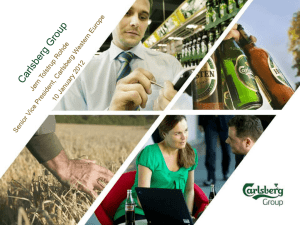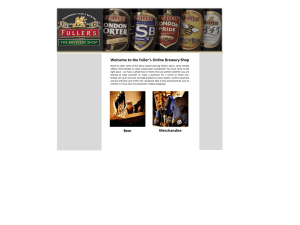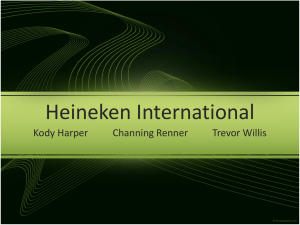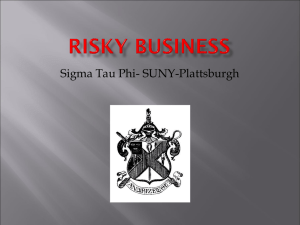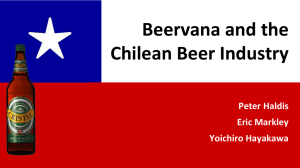Beer Industry
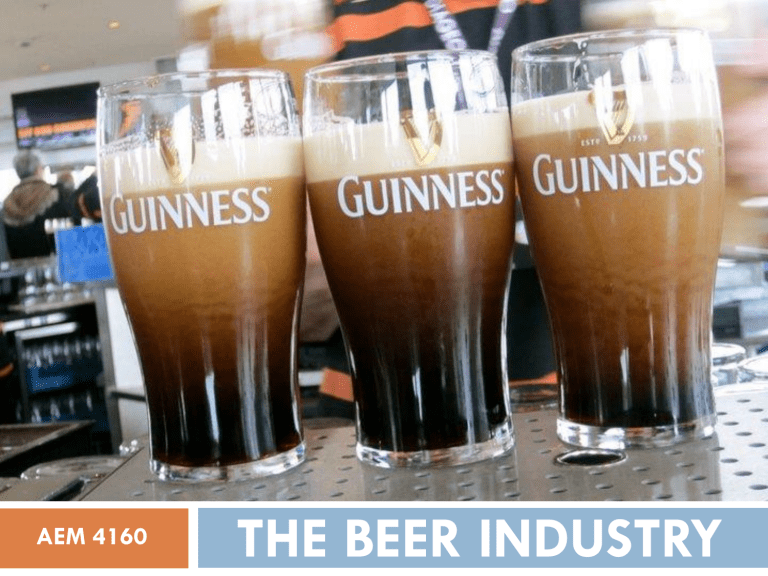
AEM 4160
THE BEER INDUSTRY
AGENDA.
Industry Overview
Major Players
Primary Pricing
Strategies
Secondary Pricing
Strategies
Case Study
Recommendations
T HE B EER I NDUSTRY
INDUSTRY OVERVIEW.
WHY THE BEER INDUSTRY?
Undergoing major changes
Consolidation
Uses pricing strategies that we have focused on in this class
Advertising
Bulk pricing
Beer is an interesting topic, specifically for college students
INDUSTRY SNAPSHOT.
INDUSTRY STRUCTURE.
Technology Change
Capital Intensity
Barriers to Entry
Industry Assistance
Industry Globalization
Concentration Level
Competition Level
Low
High
High
Low
Medium
High
Medium
INDUSTRY REVENUE.
Growth Year Revenue ($ million) Growth %
1998
1999
2000
2001
2002
2003
2004
2005
2006
2007
2008
2009
2010
2011
33,162.2
31,991.0
29,991.4
29,355.7
29,773.0
31,275.5
29,460.4
30,742.9
31,163.0
31,060.1
28,308.9
27,393.1
28,115.9
28,783.5
-----
-3.5
-6.3
-2.1
1.4
5.0
-5.8
4.4
1.4
-0.3
-8.9
-3.2
2.6
2.4
Competition with other Industries
Beer Brewers Industry Analysis 11 of 17
Figure 1: Alcohol Sales by
Industry
33%
52%
Beer
Wine
Liquor
15%
Increasing wine consumption . Currently, beer holds a majority of the market, but that majority may be fading. A recent Gallup poll showed that more
Americans named wine over beer as their drink of choice (39 percent to 36 percent, respectively). This is in line with industry trends given that wine-industry sales grew 5% last year, while beer volume fell 1% from last years totals.
18
The gap between wine drinkers and beer drinkers is closing rapidly. Also, liquor sales are rising, but at a slower rate than recent years. The Distilled Spirits Council of the United States expects a 5% increase in year over year growth by the end of
2008, down from 4% last year.
19
Liquor sales are starting to level off. Therefore, the wine industry is the most imminent threat to beer brewers. No longer does the beer industry have an unquestioned control of the market.
Profitability of industries.
Beer brewing net profit margin is 10.50% where wine and distillery profit margin is 15.90%, compared to a 7.35% for overall consumer goods.
20
This shows us that wineries and distillers are able to make more money for dollar spent on input. Profitability is higher in the wineries and distillers industry than in the brewing industry.
Switching costs . Perhaps the biggest threat to beer brewing industry is that the switching cost of changing to a substitute good is practically non-existent. If a consumer decides to switch from being primarily a beer drinker to a wine drinker, it will cost the consumer nothing more than a couple of wine glasses to make the change. In order to obtain a sustainable competitive advantage with regards to substitutes is to develop brand loyalty.
Summary of substitute effects . It seems that liquor sales are rising at about the same rate as beer, which is much lower than the increase in wine consumption.
More importantly, consumers are not inflicted with a cost of switching between
18
Arora, Raksha. Wine May Become Toast of Alcohol Industry. Gallup. http://www.gallup.com/poll/12670/Wine-May-Become-Toast-Alcohol-Industry.aspx
19
Cheers? Liquor Sales Slow. CNBC. http://www.cnbc.com/id/22841253
20
Yahoo Finance. http://biz.yahoo.com/p/347conameu.html
DEMAND.
Continuously increases in industry
As time goes on and more people are of legal age, demand increases
Stable demand Beer prices are constant
Price and Non-Price Rivalry
Price Rivalry
No real price rivalry
Beer price increase due to inflation
Industry wide, not company specific
Also non-price based rivalry
Product innovations
Low calories, low carbs, etc.
PRODUCT DIFFERENTIATION.
Beer Style
Term used to differentiate and categorize beers
Companies use different styles to meet consumer preferences
Can vary depending on the color, flavor, strength, ingredients, production method, recipe, history, or origin of the beer
Companies offer different variations of core product
PRODUCTS OF THE BEER INDUSTRY.
INNOVATION AND TECHNOLOGY.
Technology advancements = increase in productivity
Reduction of inefficiencies
Increase operational effectiveness
The level of technology change is low
Beer Brewers Industry Analysis
INCREASE IN PRODUCTION =
Industry size.
INCREASE IN EMPLOYMENT.
industry has been increasing since 1860.
1
Year
Table 1: Decennial Production
1860 – 2000
Barrels
(In Millions) % Difference
1860
1870
3,812
6,574
-
72.5
1880
1890
1900
1910
13,347
27,561
39,330
59,485
100
106.5
42.7
51.2
1920
1930
1940
1950
1960
1970
1980
1190
2000*
9,263
3,681
54,891
88,807
-84.4
-60.3
1391.2
61.8
6.5
94,547
134,653
188,373
42.4
39.9
203,658
199,173
*Reflects 2000-2007
8.1
-
1
Beer Almanac.
Beer Brewers Industry Analysis 3 of 17
Geographic Market. Although we are focusing on domestic brewers, many of the brewers export their products overseas, while some focus domestically. Of all
St. Louis-based Anheuser Busch’s revenues, domestic sales contributed 75%, and international sales contributed 7%.
2
Denver-based Molson Coors earned
56% of their revenues from the US, compared to 25% and 19% for Europe and
Canada, respectively.
3
Of the Milwaukee-based Miller Brewing Company’s five segments – Latin America, Europe, North America, Africa and Asia and South
Africa – no more than a third of its total revenues comes from any one geographic segments.
4
SABMiller is a much more global operator.
Supply Chain.
The “big three” brewers we are studying (Miller, Bud and Coors) brew and bottle their beer on a company-owned site. They convert their raw materials into a finished product, and bottle it into pre-made containers.
Therefore, the inputs that breweries need are the raw materials (such as water, barley, hops, corn and yeast) and packaging materials (such as kegs and
PRODUCTION AND
DISTRIBUTION IN BEER INDUSTRY.
abuse, and to ensure minors are not purchasing or consuming alcohol.
Therefore, individuals and retail outlets must purchase from a licensed wholesaler or distributor. Figure 1 shows a picture of the supply chain.
Figure 2: Supply Chain
Materials:
Water
Corn
Yeast
Barley
Breweries :
Cans
Bottles
Kegs/barrels
Distributors and wholesalers
Stores
Restaurants
“Breweries” encompasses the actual brewing part of the process, as well as the bottling process and the equipment that is used during both of these processes.
According to Yahoo finance the beer brewing industry in the United States is estimated to be worth 46 billion dollars.
5
2 http://stocks.us.reuters.com/stocks/fullDescription.asp?rpc=66&symbol=BUD
3
http://www.molsoncoors.com/investor-relations/business-profiles/
4 http://www.sabmiller.com/sabmiller.com/en_gb/Our+business/About+SABMiller/Our+strategic+pr iorities/
5 http://biz.yahoo.com/ic/346.html
INDUSTRY COSTS.
CAPITAL INTENSITY.
The level of investment required is high
BARRIERS TO ENTRY.
GOVERNMENT REGULATION.
Bureau of Alcohol, Tobacco Firearms and
Explosives (ATF)
US Alcohol and Tobacco Tax and Trade Bureau
(TTB)
State regulations
IMPORTS AND EXPORTS.
IMPORTS AND EXPORTS.
Anheuser-Busch InBev and MillerCoors now control
74.3% of total market share.
Exports = increased almost eightfold, from 1.3% of revenue in 2006 to an expected 11.3% in 2011.
Imports= 13.0% share of domestic demand in
2011, worth more than $3.8 billion, is above the
2006 import level of 11.3%.
Imports and exports continue increasing
INDUSTRY TRENDS.
Mergers have increased foreign ownership
International giant South African Breweries (SAB) acquired Miller Brewing Company to form SABMiller
Molson Canada merged with Coors Brewing Company in 2005 to form Molson Coors
Three years later, these companies launched
MillerCoors, a joint venture of their operations within the United States
Combined market share= 29.0%
Beer Brewers Industry Analysis 8 of 17 less rivalry. Other factors that increase rivalry are large capital asset requirements and high switching costs.
Price-based rivalry . The beer industry does not have evidence of price wars.
Beer prices have increased, but that is mostly due to inflation. The increased prices are industry wide and not company specific. According to Barbara
Hagenbaugh of USA Today: “Retail prices for beer at supermarkets and other stores were up 3% in May from a year earlier, the biggest increase in 2
½ years, according to the latest data from the Labor Department
8 .”
Non-price based rivalry.
The beer industry primarily competes with non-price based rivalry. There are various product innovations throughout beer brewing companies such as Budweiser Select, which is Anheuser Busch’s low carbohydrate beer. Miller Brewing Company released Miller Chill throughout the
United States in July 2007 , which is a light lager that is brewed with salt and lime.
Product differentiation.
Within the industry there is a lot of product differentiation. The term used to differentiate and categorize beers is known as the beer style. Different breweries use various beer styles to meet consumer preferences. Beer styles can vary depending on the color, flavor, strength, ingredients, production method, recipe, history, or origin of the beer
9
. All of the major companies offer different variations of their core product. All beer is classified as either a lager or ale; which is determined by the production method and which type of yeast is used.
INDUSTRY STRUCTURE.
revenues of the largest firms, in comparison with the rest of the industry. The
CR4 refers to the top four largest firms. If a CR4 is greater than 40%, it implies significant concentration effects. As Table 6 shows, the CR4 of beer brewing is
77%.
Table 6: Concentration Ratio of Top Four Competitors
Company
SABMiller
Anheuser Busch
Revenues (in millions)
$ 18,620
16,685
6,190
9 of 17
Boston Brewing Co. 341
CR4*
*$41,836 / $55,000
77%
Table 7: Herfindahl Index
Company Revenues (in millions)
The Herfindahl Index is another measurement of c oncentration within an
SABMiller .10 industry. It is measured by taking the sum of the market share of all firms within
Anheuser Busch .35 the industry and squaring it. A HI greater than 1800 implies significant
Molson Coors Brewing
Boston Brewing Co.
.14 concentration effects. As Table 7 shows, the HI for beer brewing is 2362.
Others
8
HI:
9
http://en.wikipedia.org/wiki/Beer_style
.21
2362
After review of the CR4 and Herfindahl Index, it is apparent that the beer brewing industry is a concentrated industry.
Capital asset requirements . The beer brewery operations require a lot of specific assets. It approximately takes thirty days to brew Budweiser
10
. It consists of a “Beachwood Aging” process that requires large steel vessels.
Anheus er-Busch’s property, plant, and equipment equate to 51% of its overall assets. When compared to the consumer goods industry, Procter and Gamble’s property, plant, and equipment equate to only 14% of its overall assets. Beer brewery operations require a lot of specific assets. It approximately takes thirty days to brew Budweiser
11
. It consists of a “Beachwood Aging” process that requires large steel vessels. With these large assets, it would be difficult to exit the industry. Therefore, many companies stick it out through market downturns which makes overall industry profits fall.
Demand influences. There are many different variables that affect demand.
However, the beer industry consistently has an increasing demand. From 1997-
1998 Coors had a 2.9% increase in barrels consumed and Anheuser Busch experienced a 3.5% increase
12
. As time goes on and more people become of legal age, demand continuously increases. Due to this stable demand, beer prices are constant and rarely fluctuate.
Switching costs . Within the beer industry there are no switching costs. The consumer can purchase whichever beer he/she favors. However, consumers are very brand loyal. Beer companies spend millions of dollars annually on advertising. The commercials are not necessarily created to increase demand, however create brand awareness. According to Gary Wilcox of allbusiness.com:
“The majority of empirical evidence suggests that advertising expenditures are not significantly related to primary or aggregate demand for alcoholic beverages, but instead may positively impact selective demand for a particular brand or product category.
13 ”
10
http://www.destination360.com
11
http://www.destination360.com
12
http://www.business.uiuc.edu
13
http://www.allbusiness.com
T HE B EER I NDUSTRY
MAJOR PLAYERS.
MAJOR PLAYERS.
ANHEUSER-BUSCH INBEV.
Market Share: 42.6%
Brand Names: Budweiser, Bud Light, Beck's, Stella
Artois, Michelob, Natural Light, Leffe, Hoegaarden,
O'Doul's
MILLERCOORS LLC.
Market Share: 31.7%
Brand Names: Miller, Coors, Blue Moon, Mickey's,
Pilsner Urquell, Foster's, Keystone, Milwaukee's Best ,
Steel Reserve, Killian's
T HE B EER I NDUSTRY
PRICING STRATEGIES.
PRIMARY PRICING STRATEGIES.
PRIMARY PRICING STRATEGIES.
Collusion
Discounting
Sub-premium Emergence
COLLUSION OF NATIONAL FIRMS.
Collusion is an agreement made between firms to:
Divide Market Power
Set Prices
Limit Production
Lower Competition
Firms choose to collude in order to increase the overall profit margin of their respective firm.
WHY COLLUSION IS POSSIBLE.
Industry must be controlled by A FEW MAJOR FIRMS.
A-B and MillerCoors control 80% of market share (Oligopoly).
SIMILAR COSTS among top firms, with respect to production, advertising, etc.
Close to EQUAL DEMAND for product.
SIMILAR PRODUCTS.
COLLUSION ENABLES FIRMS TO:
Set prices relatively high.
Leads to increased Profit Margin.
Change price freely with minimal resistance.
Price will then, usually, only changes in a vertical direction.
Internally expand.
Leads to Economies of Scale.
AFFECT ON CONSUMERS.
Consumers must pay HIGHER OVERALL PRICE for products in this market.
This is the reason why a 12 pack of Miller Lite and Bud
Lite are more expensive than most other brands in the same category.
Consumers choose beer depending on perceived benefits and qualities other than price.
REVENUE GROWTH.
YEAR
1998
1999
2000
2001
2002
2003
2004
2005
2006
2007
2008
2009
2010
2011
REVENUE
$ MILLION
33,162.2
31,991.0
29,991.4
29,355.7
29,773.0
31,275.5
29,460.4
30,742.9
31,163.0
31,060.1
28,308.9
27,393.1
28,115.9
28,783.5
GROWTH
%
-3.5
-6.3
-2.1
1.4
5.0
-5.8
4.4
1.4
-0.3
-8.9
-3.2
2.6
2.4
Revenues, along with the Price
Volatility of key brewing ingredients dropped due to expansion of the CRAFT
BREWERY SEGMENT.
Profit increased as a percentage of revenue to
11.1% in 2011, compared to
10.8% of revenue in 2006.
DISCOUNT PRICING OR BULK PRICING.
Sell large quantities of beer at an attractive price.
Pay less per unit.
Requires consumer to trade down to sub-premium brands.
Second-Degree Price Discrimination.
SUB-PREMIUM SALES TRENDS.
30 PACKS GREW 18.2% IN US DOLLAR SALES
(2009).
18 PACKS GREW 35.5% IN US DOLLAR SALES
(2009).
Source: Category Focus: 2010 Beer Report: Sub-premium, crafts lead the way
PREMIUM SALES TRENDS.
30 PACKS GREW 6.4% IN US DOLLAR SALES
(2009).
36 PACKS GREW 15.8% IN US DOLLAR SALES
(2009).
Source: Category Focus: 2010 Beer Report: Sub-premium, crafts lead the way
WHY BUY IN BULK?
Consumers now realize that buying a large number of beers for a discounted price is efficient for our wallets.
AND…
Buying in bulk is convenient, saving us both time and effort.
SHARES OF PREDICTED ANNUAL SALES
BY VOLUME PACKAGE SIZE.
100%
50%
0%
72 OZ 144 OZ
PACKAGE SIZE
Source :RTI International, Research Triangle Park, NC, USA
288 OZ
BUYING IN BULK.
You can expect to pay about $11.99 for a 12-pack of 12-ounce cans at a typical grocery store
BUT, at Costco, a 30-pack of 12-ounce cans sells for
$19.99!
About 67 cents per can versus about $1 per can at a supermarket.
Source: MSN.com 10 bulk-buying bargains
EMERGENCE OF SUB-PREMIUM BRANDS.
Several factors caused shift from premium brands towards sub-premium brands :
Current economy
Price of national premium brands held constant
Sub-premium dominate bulk market
Improved image of sub-premium brands
Perceived “coolness
ALL LEAD CONSUMER TO TRADE DOWN!
BEER SALES & THE CURRENT ECONOMY.
As the unemployment rate has gone up, beer sales have plummeted at the exact same time.
Consumers more cost efficient.
Source: IBIS World: Beer Production in the US
PREMIUM PRICES HELD CONSTANT.
A-B and MillerCoors have held prices constant and cut costs of production and marketing instead.
Consumers enticed to trade down to sub-premium level in order to save money
TOP BRANDS STILL DOMINATE BUT CONSUMERS
DETERMINE WHICH SEGMENT IS MOST POPULAR.
Source: Anheuser-Busch Companies, Inc.
IMPROVED IMAGE.
Keystone Light beer, the top share grower in the convenience store channel
Keystone recently embarked on National advertising campaign
Keith Stone Commercials
One of the most preferred drinks for college kids nationwide.
Keystone Light is a hot brand for beer drinkers looking for value in today's economy
OVERVEIW.
National brands able to manipulate price due to high market share
A-B and MillerCoors hold prices constant during recession.
Drops in sales and revenue
Consumers shifting towards buying in bulk to save money
Leads to a shift in preferred segment
Premium light Sub-premium light
Customers haven't stopped drinking. They just want to pay less for a buzz.
SECONDARY PRICING STRATEGIES.
A WORD ON COMPETITION.
HOW IS COMPETITION IS EVOLVING PRICES IN THE
DOMESTIC BEER INDUSTRY?
INCREASINGLY COMPETITIVE!
Four largest corporations generate 81.8% of the revenue.
Same four corporations also produce 74.3% of all the beer in the United States.
However, domestic beer companies are facing increased competition.
High market concentration.
WHY IS THIS IMPORTANT?
Affects the way beer companies strategically price their beer.
Second-Degree Price Discrimination.
Consumers self select into different beer consumption categories.
WHY IS COMPETITION INCREASING?
Target Market
Social Trends
Consumer Loyalty
Evolution of Drinking Habits
TARGET MARKET.
Major beer companies now try to advertise primarily to the age group of 21-35.
Underage drinking?
How do beer companies keep their aging consumers loyal to their product?
Younger demographic wants to pay a lower price for substantial volume!
CONSUMER LOYALTY.
Loyal Consumers
Older Demographic
Ages 35+
Have a beer they grew up with and prefer.
Less Likely to be influenced by price fluctuations.
Not Loyal Consumers
Younger Demographic
College Students
Those interested in buying in bulk.
Those influenced by current social trends.
Price Influenced Easily
SOCIAL/DRINKING TRENDS.
Especially for primary target market, drinking habits have evolved.
Binge Drinking
Pre-Gaming
Underage drinking has become commonplace on college campuses.
Emergence of other options that promote quick inebriation. (Ex: Four Loko)
INDUSTRY COSTS AFFECT PRICES.
So what are some pricing strategies that domestic beer companies have used to evolve along with consumers?
How Do We Get
More?
SECONDARY PRICING STRATEGIES.
Two Primary Strategies
1. Advertising less on the basis of price.
2. Incorporate common craft beer practices into major company practices.
ADVERTISING TRENDS.
Major beer companies rarely advertise on the basis of price.
Consumer Benefits are now the focus.
Taste, Quality,
Intangibles.
THINK- Can you even remember the last time you saw a beer commercial that mentioned prices?
I DO/DO NOT BUY THIS PRODUCT
BECAUSE…
Pros
I feel nostalgic when drinking it. (Intangible)
I like the taste. (Taste)
The beer is not too filling. (Intangible)
My friends also enjoy the beer. (Intangible)
Cons
The product triggers no social feelings inside an individual. (Intangible)
Bad taste. (Taste)
Unhealthy. (Quality)
Lots of calories. (Quality)
I’m the only one who likes this beer among my group of friends. (Intangible)
EXAMPLES/TRENDY SLOGANS.
“Great taste, less filling” – Miller Lite
“Drinkability” – Bud Light
“The King of Beers” – Budweiser
“The Banquet Beer” – Coors
“Cold as the Rockies” – Coors Light
WHY IS THIS CONDUCIVE?
Allows major beer companies to keep prices are a relatively high, stable level. (Collusion)
Also, less attention is paid to potential price fluctuations.
They want you to focus on perceived consumer and social benefits!
ARE WE INFLUENCED BY SOCIAL
NORMS?
CRAFT STYLE IMPLEMENTATION.
Major beer brands are starting to implement more consumer friendly practices that craft beers have always provided.
CRAFT BEERS GROWING.
From 2003-2011, production of craft beer as risen from 5,137 million barrels per year to
10,097 million barrels per year.
Almost Doubled!
Demand Increase
MAJOR BEER COMPANY ACTIONS.
Actions
Beer Tasting Opportunities.
Brewery Tours.
Consumer Appreciation
Events.
They do not want to lose their consumers to smaller craft beer companies!
Results
Potential to attract new consumers.
Increase overall consumer base.
Potential demand increase for their product as a result.
Can manipulate prices in their favor when demand and their market share is high.
T HE B EER I NDUSTRY
CASE STUDY.
CASE STUDY.
BEER ADVERTISING AND
MARKETING UPDATE:
Structure, Conduct, and Social Costs.
By: Jon P. Nelson
BEER AVERTISING: AN OVERVEIW.
The U.S. brewing industry is dominated by three firms, who together account for about 80% of beer shipments.
Anheuser- Busch
SAB-Miller
Coors
SOURCE: Nelson, Jon. (2005). Beer advertising and marketing update: structure, conduct, and social costs. http://www.springerlink.com/content/g6774l01385x5p37/
SAB-MILLER.
1970: Philip Morris acquires the Miller Brewing Company.
First to launch a “Lite” beer in 1975.
Obtains the First-Mover advantage in the Lite Beer market.
Miller Lite advertising expenditures had grown from $15 million in 1975, to $67 million ($0.33 per case) in 1986.
1988: Rival Bud Light hits peak advertising at $70 million
($0.51 per case).
Not until 1994, do sales of Bud Light surpass those of Miller Lite.
First-mover advantage and the success of the light beer category, means “light beer war” affects all subsequent advertising and marketing decisions by leading brewers.
SOURCE: Nelson, Jon. (2005). Beer advertising and marketing update: structure, conduct, and social costs. http://www.springerlink.com/content/g6774l01385x5p37/
NEW COMPETITION PROSPERS.
New Competition: Specialty Brewers, Microbrewers, and
Brewpubs.
Sell at super-premium prices.
With the exception of a few, many abstain from heavy national advertising.
Rivalry among industry leaders has spilled into the market for Flavored Malt Beverage-
Evokes new forms of competition, and new strategies for marketing and advertising.
This recent product innovation presents the consumer with a variety of choices may spark a renewed advertising rivalry amongst industry leaders.
Marketing reflects consumer tastes for lighter beverages.
Might be the next runaway product category.
SOURCE: Nelson, Jon. (2005). Beer advertising and marketing update: structure, conduct, and social costs. http://www.springerlink.com/content/g6774l01385x5p37/
AVERTISING AND STRUCTURAL CHANGE.
1950–1986: Intense advertising rivalry among the top three brewers:
Anheuser-Busch, Pabst, and Schlitz. Followed by by an intense advertising rivalry between Anheuser-Busch and Miller during the “light beer war.”
Successfully exploited the new medium of television and the economies of scale associated with national advertising and distribution.
Structural change marked by increased size of individual and multi-plant operations by the industry leaders.
Schlitz and Stroh merged and Pabst dropped out of the top group.
Independent mass-market brewers declines to 33 in 1986.
1987-1995: The total number of firms rises, and there is an expansion of microbreweries
Market share of the top three firms rises from 75% in 1990 to 80% in 1995.
1996–2003: Stroh goes out of business and sells brand names to Miller and
Pabst.
2002, Miller Brewing sold by Philip Morris to South African Breweries Ltd. (SAB).
SOURCE: Nelson, Jon. (2005). Beer advertising and marketing update: structure, conduct, and social costs. http://www.springerlink.com/content/g6774l01385x5p37/
AVERTISING AND STRUCTURAL CHANGE:
MARKET SHARES AND ADVERTISING BY THE THREE LEADING BREWERS FOR THE
PERIOD 1975–2003.
SOURCE: Nelson, Jon. (2005). Beer advertising and marketing update: structure, conduct, and social costs. http://www.springerlink.com/content/g6774l01385x5p37/
AVERTISING AND STRUCTURAL CHANGE.
Anheuser-Busch and Miller demonstrate remarkable output growth between 1975 and 1990.
Anheuser’s average spending per case is below that of its smaller rivals.
Reflects advantages of size, a broader product line, and superior marketing skills.
Advertising intensities rose during1976-1985, and then stabilized for Anheuser and Miller.
Coors’ advertising continued to increase as outsiders entered the ranks of its management.
1990–2003, the leaders increase nominal spending by an additional $0.05 to $0.09 per case.
SOURCE: Nelson, Jon. (2005). Beer advertising and marketing update: structure, conduct, and social costs. http://www.springerlink.com/content/g6774l01385x5p37/
CONSUMER PREFERENCES AND
ADVERTISING.
SOURCE: Nelson, Jon. (2005). Beer advertising and marketing update: structure, conduct, and social costs. http://www.springerlink.com/content/g6774l01385x5p37/
CONSUMER PREFERENCES AND
ADVERTISING.
Consumer preferences and advertising interact to determine success at the brand level.
1993–2003: Among the top 10 brands, three were able to successfully enter the market:
Corona Extra, Busch Light, and Heineken.
Today: Top four brands=almost half (48.5%) of U.S. beer sales
Top10 brands= two-thirds of the sales.
2003: The top four brands also accounted for 46% of beer advertising.
300000000
RAW DATA ANALYSIS.
250000000
200000000
150000000
100000000
50000000
0
BRAND
RAW DATA ANALYSIS.
BRAND NAME SUM OF DOLS
Anheuser-Busch 6962500
Television Advertising
Data: Beer Industry- Top
Four Firms.
Bud Light
Budweiser
Coors
Coors Light
Miller Genuine Draft
64
Miller Lite
277952000
156336000
13836500
133489300
Of the top four industry leaders, Bud has the largest Market Power, as it incurs the most DOLS.
9264500
121165300
RAW DATA ANALYSIS.
ANALYSIS:
DOW RELATIONSHIP
TO DOL SUM FOR
TOP FOUR FIRMS.
RAW DATA ANALYSIS.
ANALYSIS:
DOW AND DAY
PART
RELATIONSHIP
TO DOL SUM
FOR TOP FOUR
FIRMS.
RAW DATA ANALYSIS.
ANALYSIS:
DOW AND DAY
PART
RELATIONSHIP
TO DOL SUM
FOR TOP FOUR
FIRMS.
RAW DATA ANALYSIS.
ANALYSIS:
DOW AND DAY
PART
RELATIONSHIP
TO DOL SUM
FOR TOP FOUR
FIRMS.
T HE B EER I NDUSTRY
RECCOMENDATIONS.
THE INDUSTRY NOW.
2008 Merger activity between Anheuser-Busch
InBev and MillerCoors led to industry shift.
Anheuser-Busch InBev and MillerCoors control 74.3% of total market share.
Allowed the international companies InBev and
SABMiller higher levels of control over breweries that originated domestically.
Trade has heavily influenced industry revenue.
Imports and exports fell drastically when unemployment worries stalled booming global consumption and trade.
THE INDUSTRY NOW.
Supply and demand shifts in recent years, induced by unpredictable ingredient prices and changing consumer preferences, are created turmoil in the
Beer Production industry.
Faces increasing competition from other beverages, namely wines and spirits
Increase wine and spirit demand (consumer taste expansion/shift), leads to a decrease in the demand for beer.
RECOMMENDATIONS.
ADVERTISING.
Maintain consistent and strategic marketing messages, and building and preserving a high level of trust with customers.
Consumers know what to expect from both the company and their products.
Promote the brand that is beer.
The four fundamental strengths of beer:
1) Beer is genuine.
2) Beer is real.
3) Beer lacks the pretenses often associated with wine or liquor.
4) Beer brings people together; beer is about refreshment, enjoyment and fun.
Reaffirm these four strengths in both developing and loyal consumers.
RECOMMENDATIONS.
PRODUCT DEVELOPMENT.
The use of technology and continued innovation to make product personalization easier and product upgrades more accessible to the consumer.
A shift in consumer expectations, attitudes and preferences to things such as satellite TV, smart phone, and Internet connections.
Constant access to information has led a dramatic shift in consumer culture, ideas and lifestyles.
Must must meet the new consumer demand for People more variety, more novelty, more sophistication in the products offered in the market.
Example: New Trend Low Calorie Beers
Budweiser Select 55 (55 calories)
Miller Genuine Draft 64, MGD 64 (64 calories)
RECOMMENDATIONS.
PRODUCT DEVELOPMENT (continued).
Brand Expansion.
Capitalize on the success of a solid brand by breaking into different product categories under the same brand name.
Allows firm to increase and leverage the brand equity, increase product portfolio, and grants a company a larger hold over the market; thus generating greater revenue.
T HE B EER I NDUSTRY
